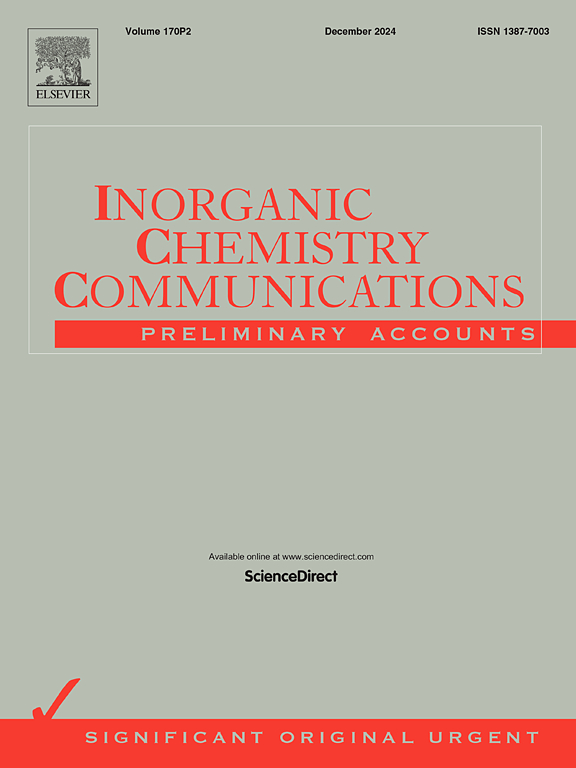由杂蒽希夫碱及其单核二有机锡(IV)配合物衍生的三齿配体的抗菌、抗氧化作用及其计算研究
IF 4.4
3区 化学
Q1 CHEMISTRY, INORGANIC & NUCLEAR
引用次数: 0
摘要
为了满足对新型治疗剂日益增长的需求,我们通过多步反应合成了12种新的杂蒽衍生物二有机锡(IV)配合物,并利用NMR、HRMS、FTIR、单晶X-RD等多种光谱技术对其进行了结构表征。配合物7的晶体结构显示配体以三齿ONO方式与二苯基锡(IV)部分结合,产生方形锥体几何形状。采用串联稀释法对合成的化合物进行多菌株体外抗菌效果筛选。杂蒽衍生的二有机锡(IV)配合物比希夫碱配体更有活性。配合物7 (MIC范围= 0.0047 ~ 0.0098µmol/mL)、14 (MIC范围= 0.0045 ~ 0.0091µmol/mL)和15 (MIC范围= 0.0043 ~ 0.0086µmol/mL)对微生物菌株的活性与参比药相当。二有机锡(IV)配合物的抑菌活性依次为二苯基锡;dibutyltin祝辞diethyltin祝辞dimethyltin。此外,以抗坏血酸为参照,通过DPPH测定来评估抗氧化能力。结果表明,金属部分的加入和羟基的存在导致所有合成的配合物具有相当的抗氧化活性。配合物11 (IC50 = 3.1µM)具有较高的活性。此外,通过DFT计算出配体3及其相应配合物12-15的可变量子参数和优化几何形状。本文章由计算机程序翻译,如有差异,请以英文原文为准。

Exploring the antimicrobial, antioxidant efficacies and computational studies of tridentate ligands derived from xanthene Schiff base and their mononuclear diorganotin(IV) complexes
In response to the growing need for new therapeutic agents, we have synthesized twelve new diorganotin(IV) complexes derived from xanthene derivatives through multistep reactions and structurally characterized using various spectral techniques, including, NMR, HRMS, FTIR, single crystal X-RD etc. The crystal structure of complex 7 reveals the ligand is bound to the diphenyltin(IV) moiety in a tridentate ONO manner, producing a square pyramidal geometry. The in-vitro antimicrobial efficacy of the synthesized compounds was screened using numerous strains via the serial dilution method. Xanthene derived diorganotin(IV) complexes were found to be more active than Schiff base ligands. Complexes 7 (MIC range = 0.0047–0.0098 µmol/mL), 14 (MIC range = 0.0045–0.0091 µmol/mL), and 15 (MIC range = 0.0043–0.0086 µmol/mL) exhibited comparable activity with reference drug towards microbial strains. Antimicrobial activity for diorganotin(IV) complexes follows the order as diphenyltin > dibutyltin > diethyltin > dimethyltin. Further, antioxidant potency was assessed via the DPPH assay using ascorbic acid as a reference. Results indicated that the incorporation of metal moiety and presence of hydroxyl group, led to comparable antioxidant activity in all synthesized complexes. Complex 11 (IC50 = 3.1 µM) exhibited higher activity. Additionally, variable quantum parameters and optimized geometry of ligand 3 and its corresponding complexes 12–15 were figured out by DFT.
求助全文
通过发布文献求助,成功后即可免费获取论文全文。
去求助
来源期刊

Inorganic Chemistry Communications
化学-无机化学与核化学
CiteScore
5.50
自引率
7.90%
发文量
1013
审稿时长
53 days
期刊介绍:
Launched in January 1998, Inorganic Chemistry Communications is an international journal dedicated to the rapid publication of short communications in the major areas of inorganic, organometallic and supramolecular chemistry. Topics include synthetic and reaction chemistry, kinetics and mechanisms of reactions, bioinorganic chemistry, photochemistry and the use of metal and organometallic compounds in stoichiometric and catalytic synthesis or organic compounds.
 求助内容:
求助内容: 应助结果提醒方式:
应助结果提醒方式:


